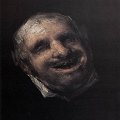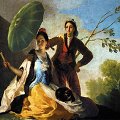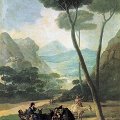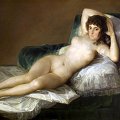Francisco de Goya

 Francisco de Goya is an innovative Spanish Romanticism painter, one of the great Spanish masters. As an
artist, Goya was by temperament far removed from the classicals. In a
few works he approached Classical style, but in the greater part of
his work the Romantic triumphed. Straightforward candor and honesty
are present in all Goya's works. The subversive and subjective element
in his art, as well as his bold handling of paint, provided a model
for the work of later generations of artists. For the bold technique
of his paintings, the haunting satire of his etchings, and his belief
that the artist's vision is more important than tradition, Goya is
often called "the grandfather of modern art". Francisco de Goya became
one of the most influential figures in Spanish art of all time. He was
also extremely important in the development of modern aesthetic
sensibility, a forerunner of Romanticism, both in the content of his
paintings, with their in-depth exploration of reality and references
to the dream world, and in his very original technique.
Francisco de Goya is an innovative Spanish Romanticism painter, one of the great Spanish masters. As an
artist, Goya was by temperament far removed from the classicals. In a
few works he approached Classical style, but in the greater part of
his work the Romantic triumphed. Straightforward candor and honesty
are present in all Goya's works. The subversive and subjective element
in his art, as well as his bold handling of paint, provided a model
for the work of later generations of artists. For the bold technique
of his paintings, the haunting satire of his etchings, and his belief
that the artist's vision is more important than tradition, Goya is
often called "the grandfather of modern art". Francisco de Goya became
one of the most influential figures in Spanish art of all time. He was
also extremely important in the development of modern aesthetic
sensibility, a forerunner of Romanticism, both in the content of his
paintings, with their in-depth exploration of reality and references
to the dream world, and in his very original technique.
Life of Goya
Early Training and First Projects
Goya was born in the small Aragonese town of Fuendetodos (near Saragossa) on March 30, 1746. His father was a painter and a gilder of altarpieces, and his mother was descended from a family of minor Aragonese nobility. Facts of Goya's childhood are scarce. He attended school in Saragossa at the Escuelas Pias. Goya's formal artistic education commenced when, at the age of 14, he was apprenticed to a local master, Jose Luzan, a competent although little-known painter in whose studio Goya spent four years.
 In 1763 the young artist went to Madrid, where he hoped to win
a prize at the Academy of San Fernando (founded 1752). Although he did
not win the desired award, he did make the acquaintance of Francisco
Bayeu, an artist also from Aragon, who was working at the court in the
academic manner imported to Spain by the German painter Anton Raphael
Mengs. Bayeu (the brother of Goya's wife) was influential in forming
Goya's early style and was responsible for his participation in an
important commission, the fresco decoration (1771, 1780-1782) of the
Church of the Virgin in El Pilar in Saragossa.
In 1763 the young artist went to Madrid, where he hoped to win
a prize at the Academy of San Fernando (founded 1752). Although he did
not win the desired award, he did make the acquaintance of Francisco
Bayeu, an artist also from Aragon, who was working at the court in the
academic manner imported to Spain by the German painter Anton Raphael
Mengs. Bayeu (the brother of Goya's wife) was influential in forming
Goya's early style and was responsible for his participation in an
important commission, the fresco decoration (1771, 1780-1782) of the
Church of the Virgin in El Pilar in Saragossa.
In 1771 Goya went to Italy for approximately one year. His activity there is relatively obscure; he spent some months in Rome and also entered a composition at the Parma Academy competition, in which he was successful. Returning to Spain about 1773, Goya participated in several other fresco projects, including that for the Charterhouse of Aula Dei, near Saragossa, in 1774, where his paintings prefigure those of his greatest fresco project, executed in the Church of San Antonio de la Florida, Madrid, in 1798. It was at this time that Goya began to do prints after paintings by Velazquez, who would remain, along with Rembrandt, his greatest source of inspiration.
Years as Court Painter
 By 1786 Goya was working in an official capacity for King Charles III,
the most enlightened Spanish monarch of the 18th century. Goya was
appointed first court painter in 1799. His tapestry cartoons executed
in the late 1780s and early 1790s were highly praised for their candid
views of everyday Spanish life. With these cartoons Goya
revolutionized the tapestry industry, which, until that time, had
slavishly reproduced the Flemish genre scenes of the 17th-century
painter David Teniers. Some of Goya's most beautiful portraits of his
friends, members of the court, and the nobility date from the 1780s.
Works such as Marquesa de Pontejos (1786, National Gallery,
Washington, D.C.) show that Goya was then painting in an elegant
manner somewhat reminiscent of the style of his English contemporary
Thomas Gainsborough.
By 1786 Goya was working in an official capacity for King Charles III,
the most enlightened Spanish monarch of the 18th century. Goya was
appointed first court painter in 1799. His tapestry cartoons executed
in the late 1780s and early 1790s were highly praised for their candid
views of everyday Spanish life. With these cartoons Goya
revolutionized the tapestry industry, which, until that time, had
slavishly reproduced the Flemish genre scenes of the 17th-century
painter David Teniers. Some of Goya's most beautiful portraits of his
friends, members of the court, and the nobility date from the 1780s.
Works such as Marquesa de Pontejos (1786, National Gallery,
Washington, D.C.) show that Goya was then painting in an elegant
manner somewhat reminiscent of the style of his English contemporary
Thomas Gainsborough.
Etchings and Later Paintings
In the winter of 1792, while on a visit to southern Spain, Goya contracted a serious disease that left him totally deaf and marked a turning point in his career. A mood of pessimism entered Goya's work. Between 1797 and 1799 he drew and etched the first of his great print series Los caprichos (The Caprices), which, in their satirical humor, mock the social mores and superstitions of the time.
 Later series, such
as Desastres de la guerra (Disasters of War, 1810) and Disparates
(Absurdities, 1820-1823), present more caustic commentaries on the
ills and follies of humanity. The horrors of warfare were of great
concern to Goya, who observed firsthand the battles between French
soldiers and Spanish citizens during the bloody years of the
Napoleonic occupation of Spain. In 1814 he completed Second of May,
1808 and Third of May, 1808 (both Prado). These paintings depict
horrifying and dramatically brutal massacres of groups of unarmed
Spanish street fighters by French soldiers. Both are painted, like so
many later pictures by Goya, in thick, bold strokes of dark color
punctuated by brilliant yellow and red highlights.
Later series, such
as Desastres de la guerra (Disasters of War, 1810) and Disparates
(Absurdities, 1820-1823), present more caustic commentaries on the
ills and follies of humanity. The horrors of warfare were of great
concern to Goya, who observed firsthand the battles between French
soldiers and Spanish citizens during the bloody years of the
Napoleonic occupation of Spain. In 1814 he completed Second of May,
1808 and Third of May, 1808 (both Prado). These paintings depict
horrifying and dramatically brutal massacres of groups of unarmed
Spanish street fighters by French soldiers. Both are painted, like so
many later pictures by Goya, in thick, bold strokes of dark color
punctuated by brilliant yellow and red highlights.
Straightforward candor and honesty are also present in Goya's later portraits, such as Family of Charles IV (1800, Museo del Prado), in which the royal family is shown in a completely unidealized fashion, verging on caricature, as a group of strikingly homely individuals.
Final Works
The Black Paintings, scenes of witchcraft and other bizarre activities, are among the most outstanding works of the artist's late years. Executed about 1820, these paintings are now in the Prado, Madrid. Originally painted in fresco on the walls of Goya's country house and now transferred to canvas, they attest to his progressively darkening mood, possibly aggravated by an oppressive political situation in Spain that forced him to leave for France in 1824. In Bordeaux he took up the then new art of lithography, producing a series of bullfight scenes, considered among the finest lithographs ever made. Although he returned to Madrid for a brief visit in 1826, he died in self-imposed exile in Bordeaux two years later, on April 16, 1828. Goya left no immediate followers of consequence, but his influence was strongly felt in mid-19th-century painting and printmaking and in 20th-century art.
Goya completed some 500 oil paintings and murals, about 300 etchings and lithographs, and many hundreds of drawings. He was exceptionally versatile and his work expresses a very wide range of emotion. His technical freedom and originality likewise are remarkable. In his own day he was chiefly celebrated for his portraits, of which he painted more than 200, but his fame now rests equally on his other work.
Francisco de Goya Art

|
|
More
Articles
 Art Encyclopedia A world history of art in articles.
Art Encyclopedia A world history of art in articles.
Romanticism
Francisco de Goya
Life and biography.
Art of Goya.
Early paintings by Goya.
Intermediate paintings by Goya.
Late paintings by Goya.
Art
 Art Wallpapers Art image collections for your desktop.
Art Wallpapers Art image collections for your desktop.
Goya Art, $25
(115 pictures)
Aivazovsky Art, $29
(145 pictures)
Bouguereau Art, $25
(175 pictures)
